brake sensor INFINITI QX50 2021 User Guide
[x] Cancel search | Manufacturer: INFINITI, Model Year: 2021, Model line: QX50, Model: INFINITI QX50 2021Pages: 542, PDF Size: 3.51 MB
Page 352 of 542
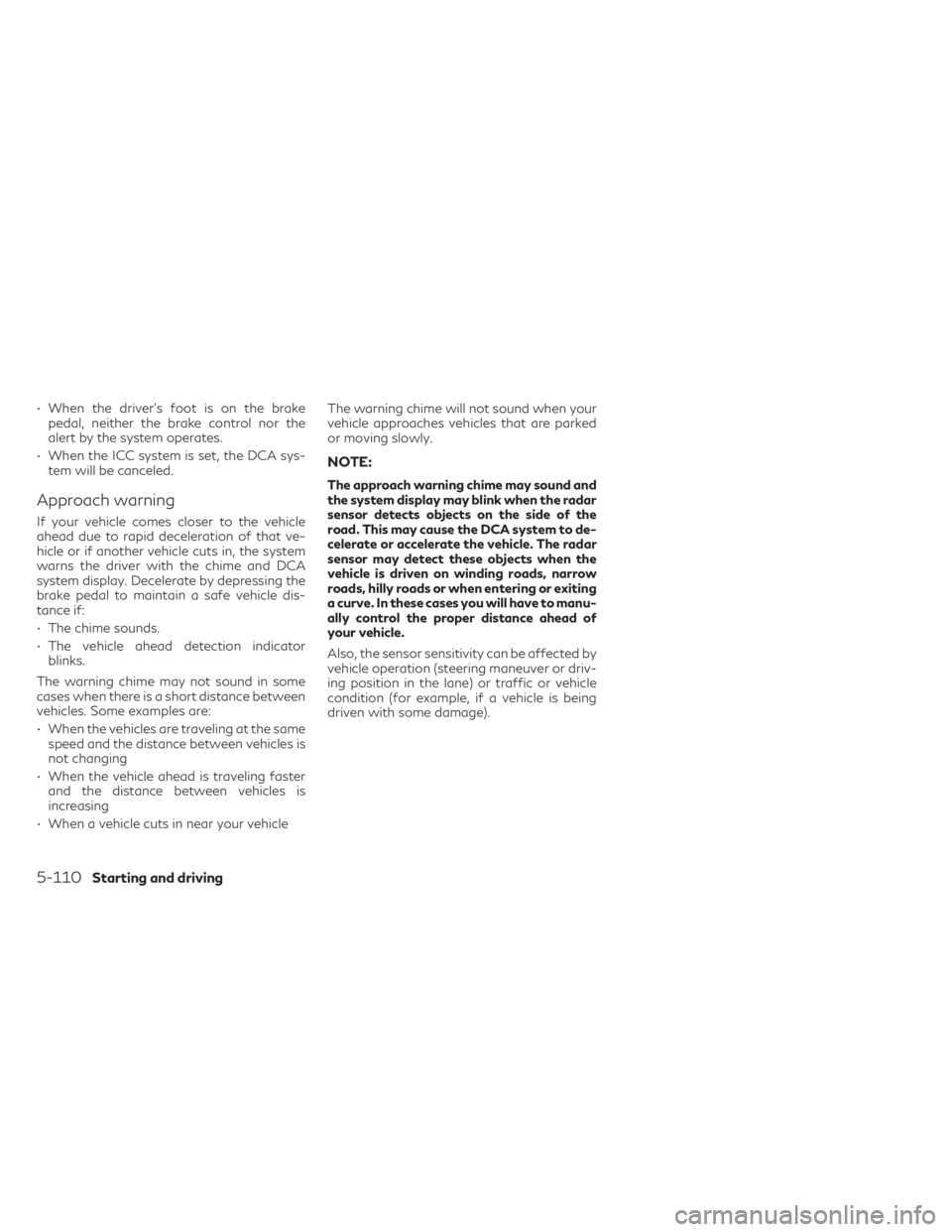
• When the driver’s foot is on the brakepedal, neither the brake control nor the
alert by the system operates.
• When the ICC system is set, the DCA sys- tem will be canceled.
Approach warning
If your vehicle comes closer to the vehicle
ahead due to rapid deceleration of that ve-
hicle or if another vehicle cuts in, the system
warns the driver with the chime and DCA
system display. Decelerate by depressing the
brake pedal to maintain a safe vehicle dis-
tance if:
• The chime sounds.
• The vehicle ahead detection indicatorblinks.
The warning chime may not sound in some
cases when there is a short distance between
vehicles. Some examples are:
• When the vehicles are traveling at the same speed and the distance between vehicles is
not changing
• When the vehicle ahead is traveling faster and the distance between vehicles is
increasing
• When a vehicle cuts in near your vehicle The warning chime will not sound when your
vehicle approaches vehicles that are parked
or moving slowly.
NOTE:
The approach warning chime may sound and
the system display may blink when the radar
sensor detects objects on the side of the
road. This may cause the DCA system to de-
celerate or accelerate the vehicle. The radar
sensor may detect these objects when the
vehicle is driven on winding roads, narrow
roads, hilly roads or when entering or exiting
a curve. In these cases you will have to manu-
ally control the proper distance ahead of
your vehicle.
Also, the sensor sensitivity can be affected by
vehicle operation (steering maneuver or driv-
ing position in the lane) or traffic or vehicle
condition (for example, if a vehicle is being
driven with some damage).
5-110Starting and driving
Page 355 of 542
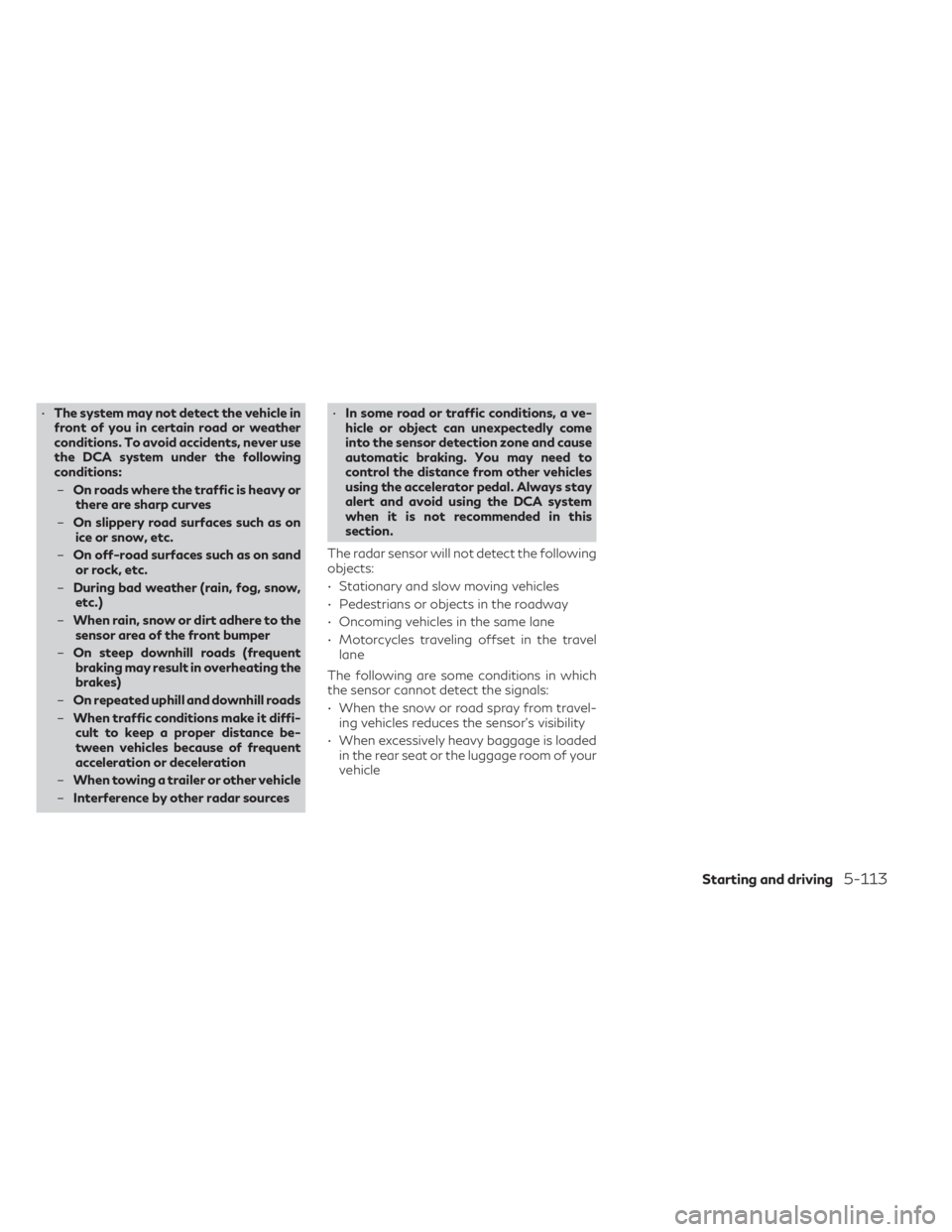
•The system may not detect the vehicle in
front of you in certain road or weather
conditions. To avoid accidents, never use
the DCA system under the following
conditions:
– On roads where the traffic is heavy or
there are sharp curves
– On slippery road surfaces such as on
ice or snow, etc.
– On off-road surfaces such as on sand
or rock, etc.
– During bad weather (rain, fog, snow,
etc.)
– When rain, snow or dirt adhere to the
sensor area of the front bumper
– On steep downhill roads (frequent
braking may result in overheating the
brakes)
– On repeated uphill and downhill roads
– When traffic conditions make it diffi-
cult to keep a proper distance be-
tween vehicles because of frequent
acceleration or deceleration
– When towing a trailer or other vehicle
– Interference by other radar sources •
In some road or traffic conditions, a ve-
hicle or object can unexpectedly come
into the sensor detection zone and cause
automatic braking. You may need to
control the distance from other vehicles
using the accelerator pedal. Always stay
alert and avoid using the DCA system
when it is not recommended in this
section.
The radar sensor will not detect the following
objects:
• Stationary and slow moving vehicles
• Pedestrians or objects in the roadway
• Oncoming vehicles in the same lane
• Motorcycles traveling offset in the travel lane
The following are some conditions in which
the sensor cannot detect the signals:
• When the snow or road spray from travel- ing vehicles reduces the sensor’s visibility
• When excessively heavy baggage is loaded in the rear seat or the luggage room of your
vehicle
Starting and driving5-113
Page 360 of 542
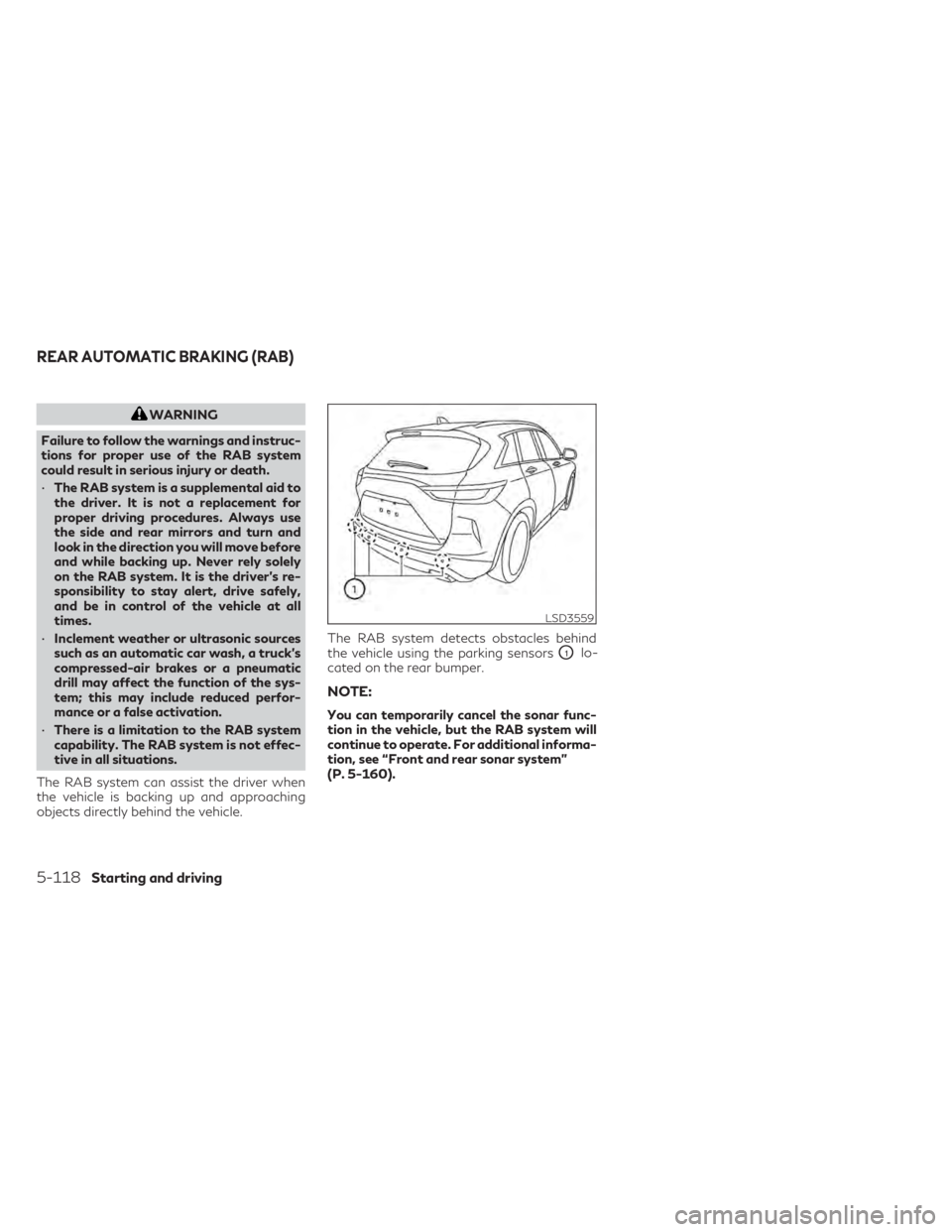
WARNING
Failure to follow the warnings and instruc-
tions for proper use of the RAB system
could result in serious injury or death.
• The RAB system is a supplemental aid to
the driver. It is not a replacement for
proper driving procedures. Always use
the side and rear mirrors and turn and
look in the direction you will move before
and while backing up. Never rely solely
on the RAB system. It is the driver’s re-
sponsibility to stay alert, drive safely,
and be in control of the vehicle at all
times.
• Inclement weather or ultrasonic sources
such as an automatic car wash, a truck’s
compressed-air brakes or a pneumatic
drill may affect the function of the sys-
tem; this may include reduced perfor-
mance or a false activation.
• There is a limitation to the RAB system
capability. The RAB system is not effec-
tive in all situations.
The RAB system can assist the driver when
the vehicle is backing up and approaching
objects directly behind the vehicle. The RAB system detects obstacles behind
the vehicle using the parking sensors
O1lo-
cated on the rear bumper.
NOTE:
You can temporarily cancel the sonar func-
tion in the vehicle, but the RAB system will
continue to operate. For additional informa-
tion, see “Front and rear sonar system”
(P. 5-160).
LSD3559
REAR AUTOMATIC BRAKING (RAB)
5-118Starting and driving
Page 363 of 542
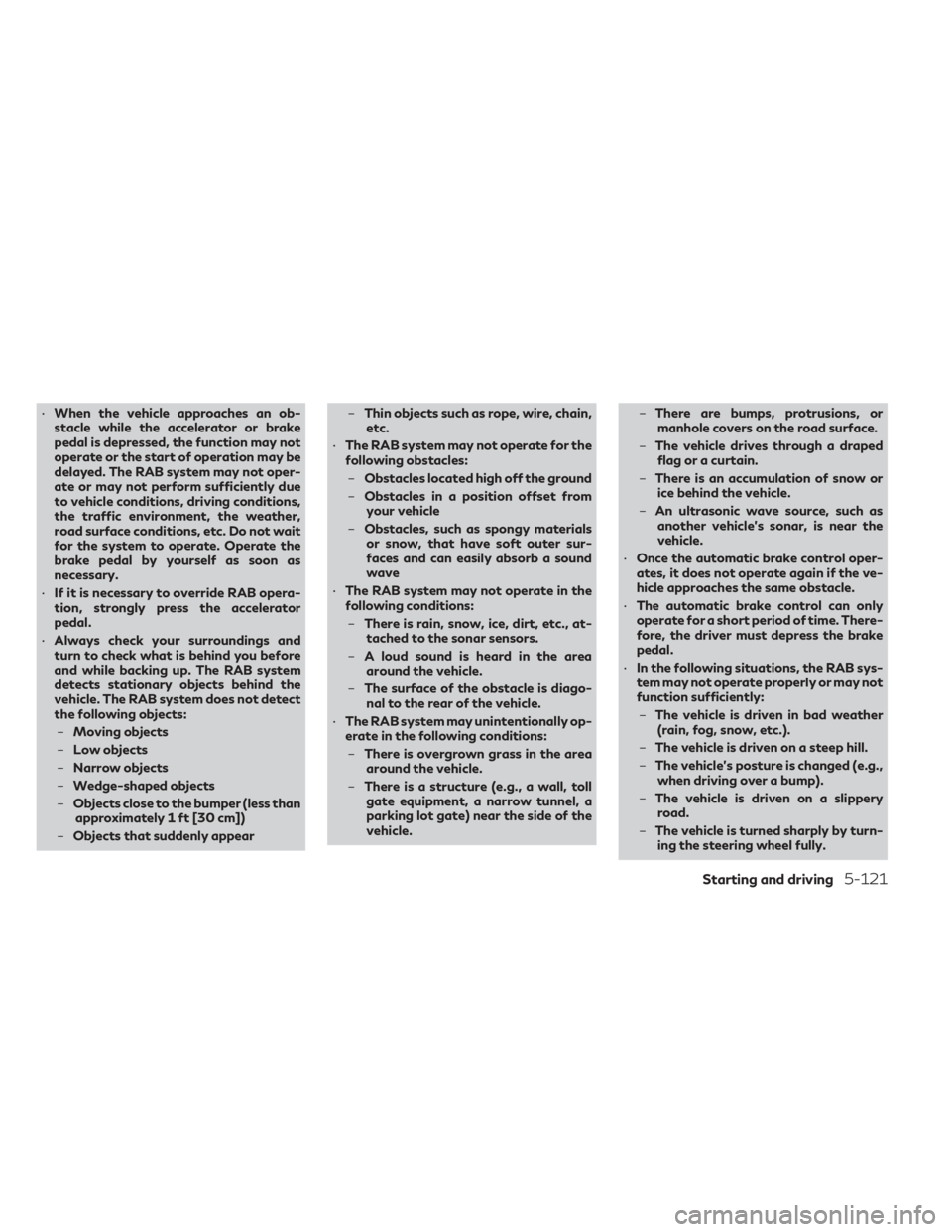
•When the vehicle approaches an ob-
stacle while the accelerator or brake
pedal is depressed, the function may not
operate or the start of operation may be
delayed. The RAB system may not oper-
ate or may not perform sufficiently due
to vehicle conditions, driving conditions,
the traffic environment, the weather,
road surface conditions, etc. Do not wait
for the system to operate. Operate the
brake pedal by yourself as soon as
necessary.
• If it is necessary to override RAB opera-
tion, strongly press the accelerator
pedal.
• Always check your surroundings and
turn to check what is behind you before
and while backing up. The RAB system
detects stationary objects behind the
vehicle. The RAB system does not detect
the following objects:
– Moving objects
– Low objects
– Narrow objects
– Wedge-shaped objects
– Objects close to the bumper (less than
approximately 1 ft [30 cm])
– Objects that suddenly appear –
Thin objects such as rope, wire, chain,
etc.
• The RAB system may not operate for the
following obstacles:
– Obstacles located high off the ground
– Obstacles in a position offset from
your vehicle
– Obstacles, such as spongy materials
or snow, that have soft outer sur-
faces and can easily absorb a sound
wave
• The RAB system may not operate in the
following conditions:
– There is rain, snow, ice, dirt, etc., at-
tached to the sonar sensors.
– A loud sound is heard in the area
around the vehicle.
– The surface of the obstacle is diago-
nal to the rear of the vehicle.
• The RAB system may unintentionally op-
erate in the following conditions:
– There is overgrown grass in the area
around the vehicle.
– There is a structure (e.g., a wall, toll
gate equipment, a narrow tunnel, a
parking lot gate) near the side of the
vehicle. –
There are bumps, protrusions, or
manhole covers on the road surface.
– The vehicle drives through a draped
flag or a curtain.
– There is an accumulation of snow or
ice behind the vehicle.
– An ultrasonic wave source, such as
another vehicle’s sonar, is near the
vehicle.
• Once the automatic brake control oper-
ates, it does not operate again if the ve-
hicle approaches the same obstacle.
• The automatic brake control can only
operate for a short period of time. There-
fore, the driver must depress the brake
pedal.
• In the following situations, the RAB sys-
tem may not operate properly or may not
function sufficiently:
– The vehicle is driven in bad weather
(rain, fog, snow, etc.).
– The vehicle is driven on a steep hill.
– The vehicle’s posture is changed (e.g.,
when driving over a bump).
– The vehicle is driven on a slippery
road.
– The vehicle is turned sharply by turn-
ing the steering wheel fully.
Starting and driving5-121
Page 364 of 542
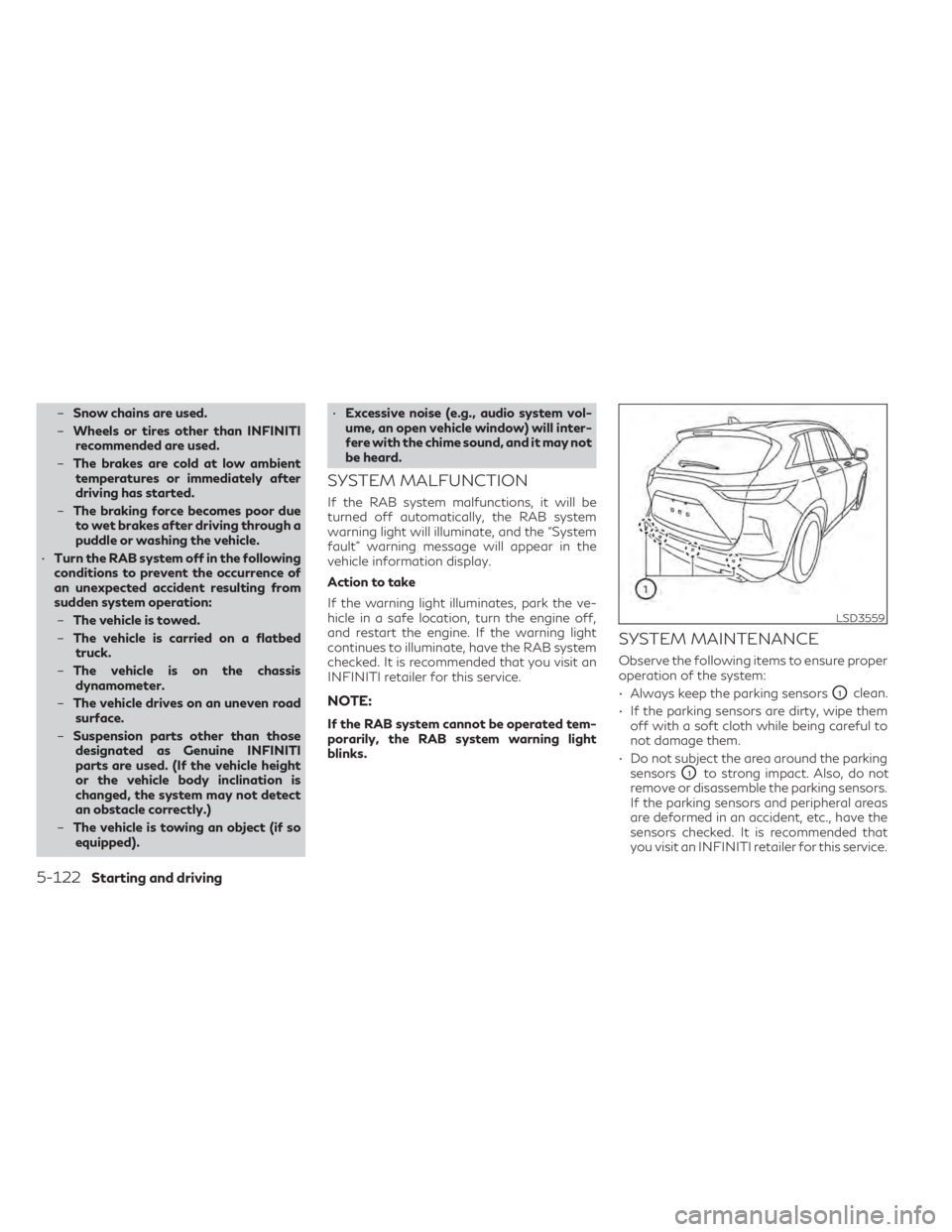
–Snow chains are used.
– Wheels or tires other than INFINITI
recommended are used.
– The brakes are cold at low ambient
temperatures or immediately after
driving has started.
– The braking force becomes poor due
to wet brakes after driving through a
puddle or washing the vehicle.
• Turn the RAB system off in the following
conditions to prevent the occurrence of
an unexpected accident resulting from
sudden system operation:
– The vehicle is towed.
– The vehicle is carried on a flatbed
truck.
– The vehicle is on the chassis
dynamometer.
– The vehicle drives on an uneven road
surface.
– Suspension parts other than those
designated as Genuine INFINITI
parts are used. (If the vehicle height
or the vehicle body inclination is
changed, the system may not detect
an obstacle correctly.)
– The vehicle is towing an object (if so
equipped). •
Excessive noise (e.g., audio system vol-
ume, an open vehicle window) will inter-
fere with the chime sound, and it may not
be heard.
SYSTEM MALFUNCTION
If the RAB system malfunctions, it will be
turned off automatically, the RAB system
warning light will illuminate, and the “System
fault” warning message will appear in the
vehicle information display.
Action to take
If the warning light illuminates, park the ve-
hicle in a safe location, turn the engine off,
and restart the engine. If the warning light
continues to illuminate, have the RAB system
checked. It is recommended that you visit an
INFINITI retailer for this service.
NOTE:
If the RAB system cannot be operated tem-
porarily, the RAB system warning light
blinks.
SYSTEM MAINTENANCE
Observe the following items to ensure proper
operation of the system:
• Always keep the parking sensors
O1clean.
• If the parking sensors are dirty, wipe them off with a soft cloth while being careful to
not damage them.
• Do not subject the area around the parking sensors
O1to strong impact. Also, do not
remove or disassemble the parking sensors.
If the parking sensors and peripheral areas
are deformed in an accident, etc., have the
sensors checked. It is recommended that
you visit an INFINITI retailer for this service.
LSD3559
5-122Starting and driving
Page 395 of 542
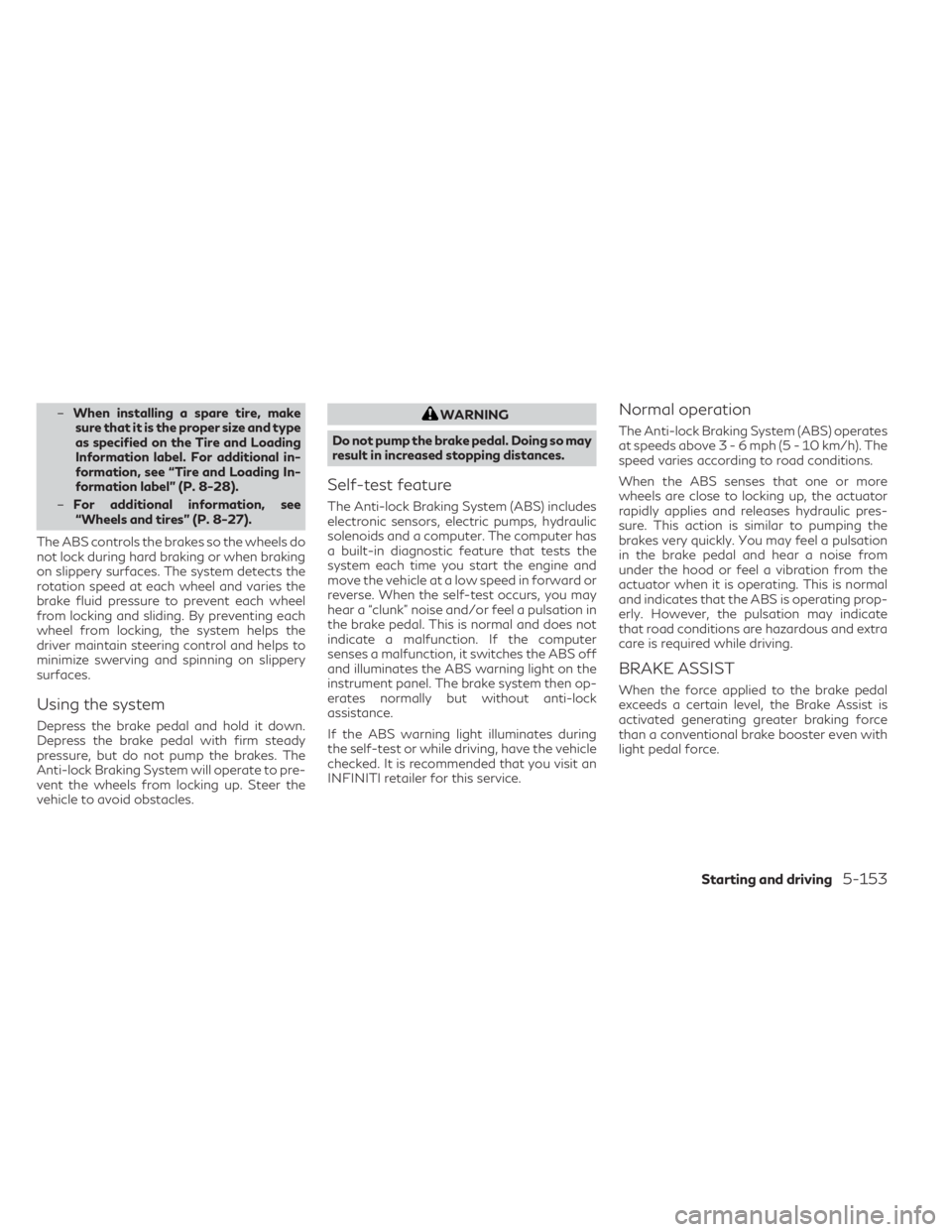
–When installing a spare tire, make
sure that it is the proper size and type
as specified on the Tire and Loading
Information label. For additional in-
formation, see “Tire and Loading In-
formation label” (P. 8-28).
– For additional information, see
“Wheels and tires” (P. 8-27).
The ABS controls the brakes so the wheels do
not lock during hard braking or when braking
on slippery surfaces. The system detects the
rotation speed at each wheel and varies the
brake fluid pressure to prevent each wheel
from locking and sliding. By preventing each
wheel from locking, the system helps the
driver maintain steering control and helps to
minimize swerving and spinning on slippery
surfaces.
Using the system
Depress the brake pedal and hold it down.
Depress the brake pedal with firm steady
pressure, but do not pump the brakes. The
Anti-lock Braking System will operate to pre-
vent the wheels from locking up. Steer the
vehicle to avoid obstacles.
WARNING
Do not pump the brake pedal. Doing so may
result in increased stopping distances.
Self-test feature
The Anti-lock Braking System (ABS) includes
electronic sensors, electric pumps, hydraulic
solenoids and a computer. The computer has
a built-in diagnostic feature that tests the
system each time you start the engine and
move the vehicle at a low speed in forward or
reverse. When the self-test occurs, you may
hear a “clunk” noise and/or feel a pulsation in
the brake pedal. This is normal and does not
indicate a malfunction. If the computer
senses a malfunction, it switches the ABS off
and illuminates the ABS warning light on the
instrument panel. The brake system then op-
erates normally but without anti-lock
assistance.
If the ABS warning light illuminates during
the self-test or while driving, have the vehicle
checked. It is recommended that you visit an
INFINITI retailer for this service.
Normal operation
The Anti-lock Braking System (ABS) operates
at speeds above3-6mph(5-10km/h). The
speed varies according to road conditions.
When the ABS senses that one or more
wheels are close to locking up, the actuator
rapidly applies and releases hydraulic pres-
sure. This action is similar to pumping the
brakes very quickly. You may feel a pulsation
in the brake pedal and hear a noise from
under the hood or feel a vibration from the
actuator when it is operating. This is normal
and indicates that the ABS is operating prop-
erly. However, the pulsation may indicate
that road conditions are hazardous and extra
care is required while driving.
BRAKE ASSIST
When the force applied to the brake pedal
exceeds a certain level, the Brake Assist is
activated generating greater braking force
than a conventional brake booster even with
light pedal force.
Starting and driving5-153
Page 396 of 542
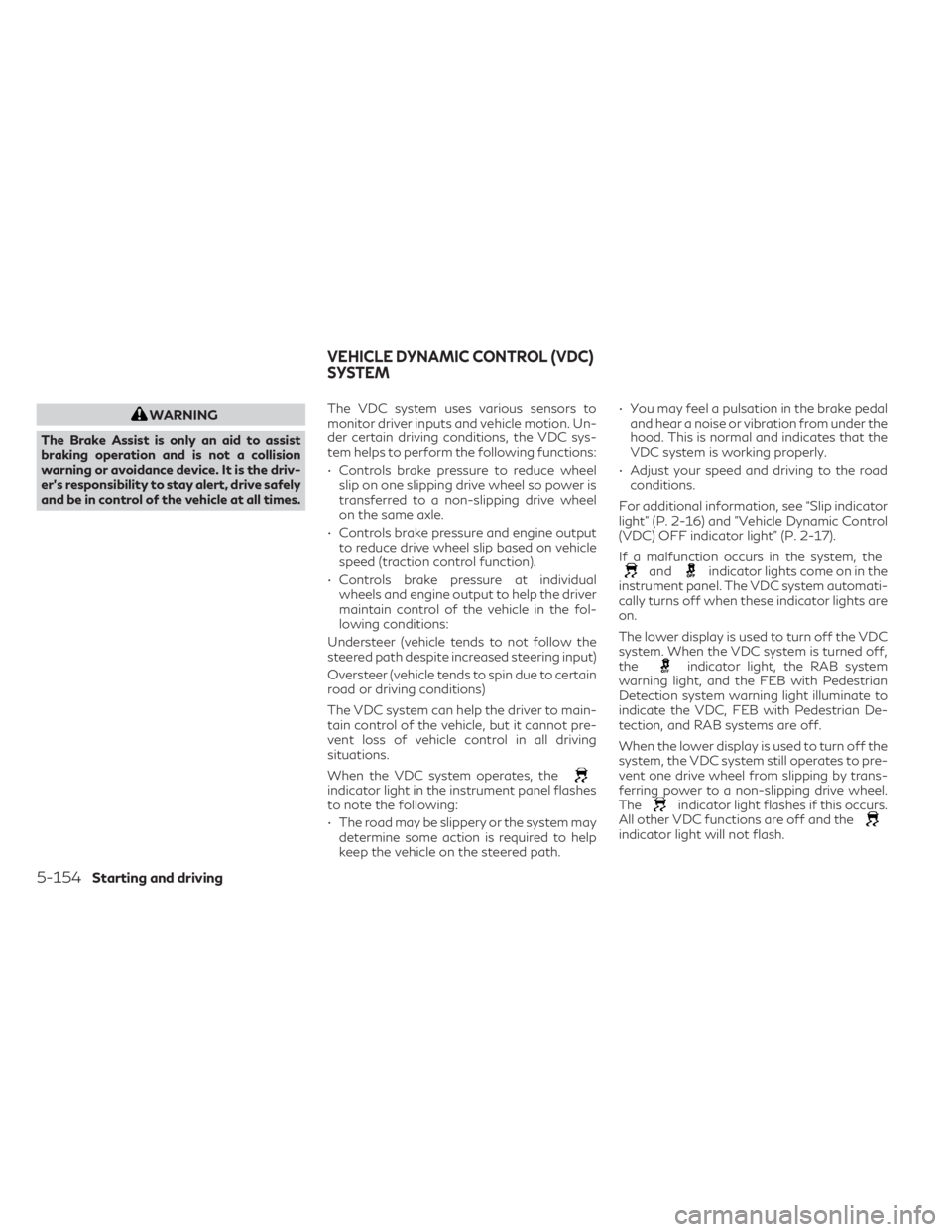
WARNING
The Brake Assist is only an aid to assist
braking operation and is not a collision
warning or avoidance device. It is the driv-
er’s responsibility to stay alert, drive safely
and be in control of the vehicle at all times. The VDC system uses various sensors to
monitor driver inputs and vehicle motion. Un-
der certain driving conditions, the VDC sys-
tem helps to perform the following functions:
• Controls brake pressure to reduce wheel
slip on one slipping drive wheel so power is
transferred to a non-slipping drive wheel
on the same axle.
• Controls brake pressure and engine output to reduce drive wheel slip based on vehicle
speed (traction control function).
• Controls brake pressure at individual wheels and engine output to help the driver
maintain control of the vehicle in the fol-
lowing conditions:
Understeer (vehicle tends to not follow the
steered path despite increased steering input)
Oversteer (vehicle tends to spin due to certain
road or driving conditions)
The VDC system can help the driver to main-
tain control of the vehicle, but it cannot pre-
vent loss of vehicle control in all driving
situations.
When the VDC system operates, the
indicator light in the instrument panel flashes
to note the following:
• The road may be slippery or the system may determine some action is required to help
keep the vehicle on the steered path. • You may feel a pulsation in the brake pedal
and hear a noise or vibration from under the
hood. This is normal and indicates that the
VDC system is working properly.
• Adjust your speed and driving to the road conditions.
For additional information, see “Slip indicator
light” (P. 2-16) and ”Vehicle Dynamic Control
(VDC) OFF indicator light” (P. 2-17).
If a malfunction occurs in the system, the
andindicator lights come on in the
instrument panel. The VDC system automati-
cally turns off when these indicator lights are
on.
The lower display is used to turn off the VDC
system. When the VDC system is turned off,
the
indicator light, the RAB system
warning light, and the FEB with Pedestrian
Detection system warning light illuminate to
indicate the VDC, FEB with Pedestrian De-
tection, and RAB systems are off.
When the lower display is used to turn off the
system, the VDC system still operates to pre-
vent one drive wheel from slipping by trans-
ferring power to a non-slipping drive wheel.
The
indicator light flashes if this occurs.
All other VDC functions are off and the
indicator light will not flash.
VEHICLE DYNAMIC CONTROL (VDC)
SYSTEM
5-154Starting and driving
Page 399 of 542
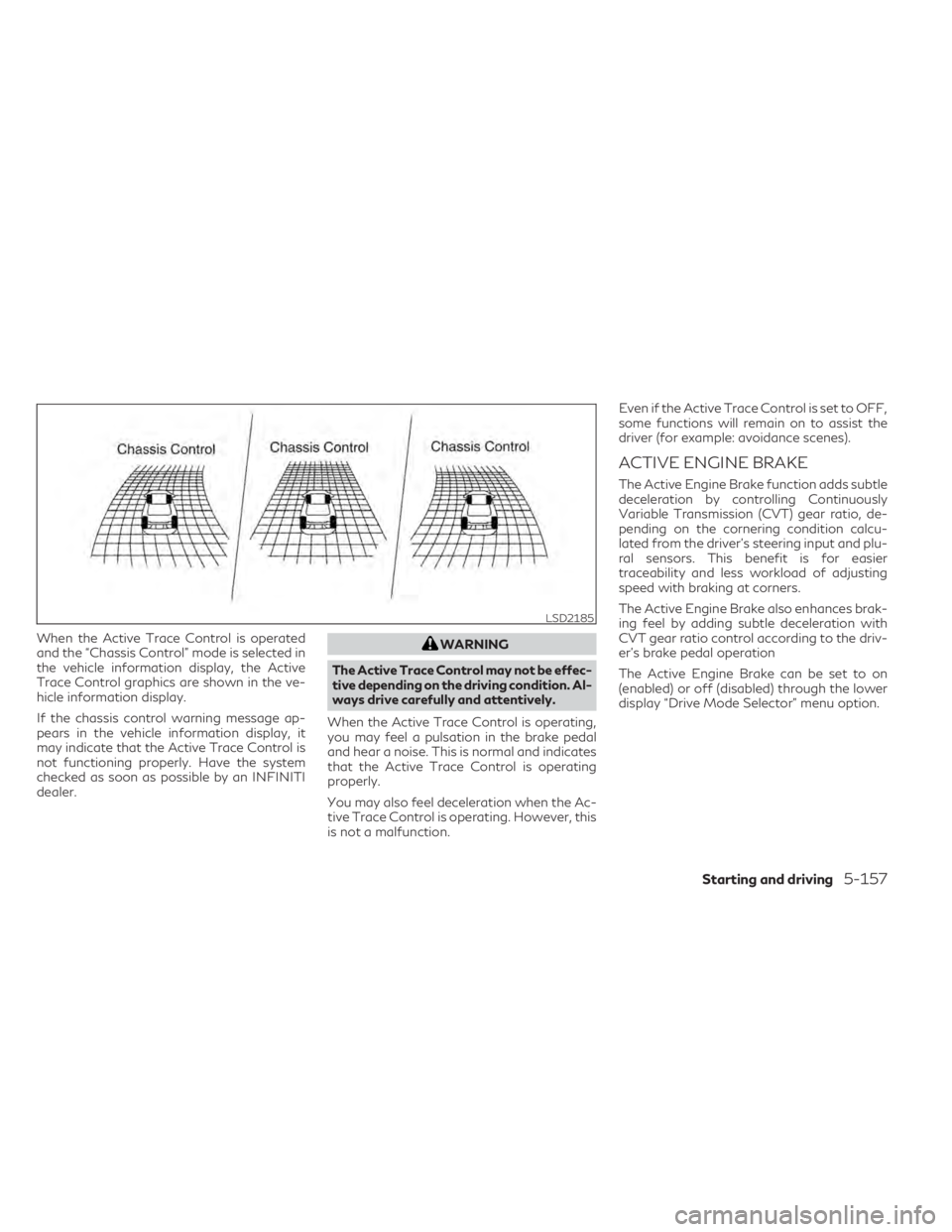
When the Active Trace Control is operated
and the “Chassis Control” mode is selected in
the vehicle information display, the Active
Trace Control graphics are shown in the ve-
hicle information display.
If the chassis control warning message ap-
pears in the vehicle information display, it
may indicate that the Active Trace Control is
not functioning properly. Have the system
checked as soon as possible by an INFINITI
dealer.WARNING
The Active Trace Control may not be effec-
tive depending on the driving condition. Al-
ways drive carefully and attentively.
When the Active Trace Control is operating,
you may feel a pulsation in the brake pedal
and hear a noise. This is normal and indicates
that the Active Trace Control is operating
properly.
You may also feel deceleration when the Ac-
tive Trace Control is operating. However, this
is not a malfunction. Even if the Active Trace Control is set to OFF,
some functions will remain on to assist the
driver (for example: avoidance scenes).
ACTIVE ENGINE BRAKE
The Active Engine Brake function adds subtle
deceleration by controlling Continuously
Variable Transmission (CVT) gear ratio, de-
pending on the cornering condition calcu-
lated from the driver's steering input and plu-
ral sensors. This benefit is for easier
traceability and less workload of adjusting
speed with braking at corners.
The Active Engine Brake also enhances brak-
ing feel by adding subtle deceleration with
CVT gear ratio control according to the driv-
er's brake pedal operation
The Active Engine Brake can be set to on
(enabled) or off (disabled) through the lower
display “Drive Mode Selector” menu option.
LSD2185
Starting and driving5-157
Page 406 of 542
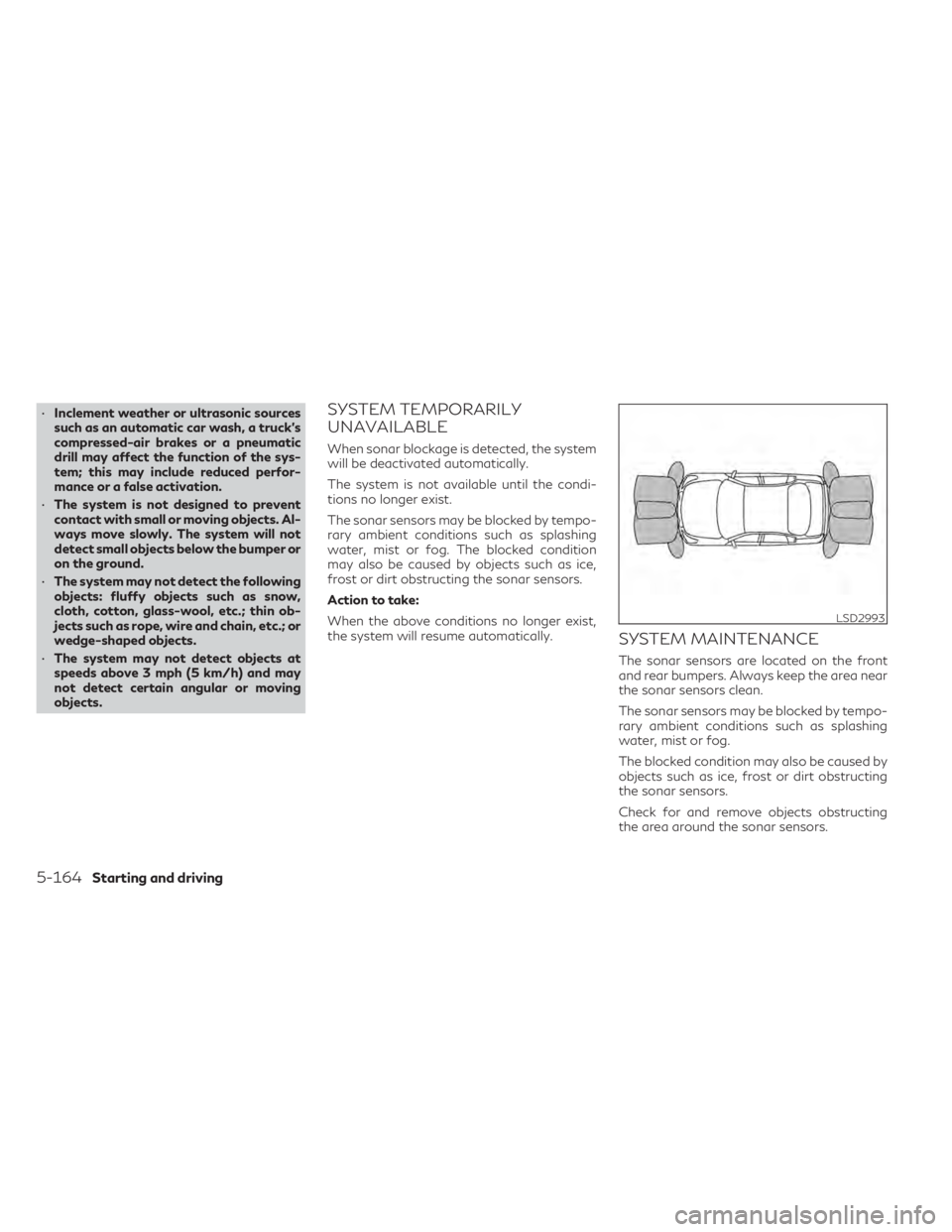
•Inclement weather or ultrasonic sources
such as an automatic car wash, a truck’s
compressed-air brakes or a pneumatic
drill may affect the function of the sys-
tem; this may include reduced perfor-
mance or a false activation.
• The system is not designed to prevent
contact with small or moving objects. Al-
ways move slowly. The system will not
detect small objects below the bumper or
on the ground.
• The system may not detect the following
objects: fluffy objects such as snow,
cloth, cotton, glass-wool, etc.; thin ob-
jects such as rope, wire and chain, etc.; or
wedge-shaped objects.
• The system may not detect objects at
speeds above 3 mph (5 km/h) and may
not detect certain angular or moving
objects.SYSTEM TEMPORARILY
UNAVAILABLE
When sonar blockage is detected, the system
will be deactivated automatically.
The system is not available until the condi-
tions no longer exist.
The sonar sensors may be blocked by tempo-
rary ambient conditions such as splashing
water, mist or fog. The blocked condition
may also be caused by objects such as ice,
frost or dirt obstructing the sonar sensors.
Action to take:
When the above conditions no longer exist,
the system will resume automatically.
SYSTEM MAINTENANCE
The sonar sensors are located on the front
and rear bumpers. Always keep the area near
the sonar sensors clean.
The sonar sensors may be blocked by tempo-
rary ambient conditions such as splashing
water, mist or fog.
The blocked condition may also be caused by
objects such as ice, frost or dirt obstructing
the sonar sensors.
Check for and remove objects obstructing
the area around the sonar sensors.
LSD2993
5-164Starting and driving
Page 468 of 542
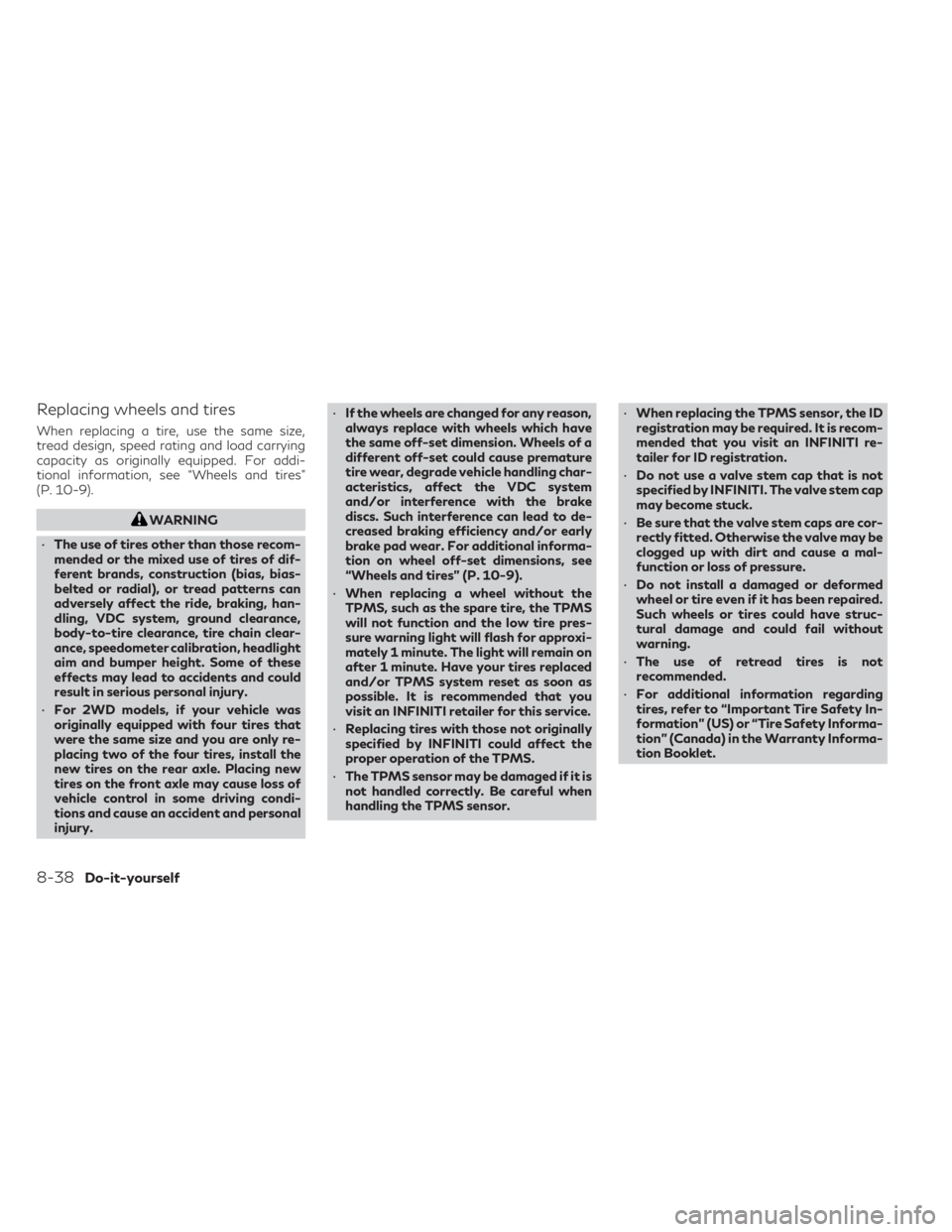
Replacing wheels and tires
When replacing a tire, use the same size,
tread design, speed rating and load carrying
capacity as originally equipped. For addi-
tional information, see “Wheels and tires”
(P. 10-9).
WARNING
• The use of tires other than those recom-
mended or the mixed use of tires of dif-
ferent brands, construction (bias, bias-
belted or radial), or tread patterns can
adversely affect the ride, braking, han-
dling, VDC system, ground clearance,
body-to-tire clearance, tire chain clear-
ance, speedometer calibration, headlight
aim and bumper height. Some of these
effects may lead to accidents and could
result in serious personal injury.
• For 2WD models, if your vehicle was
originally equipped with four tires that
were the same size and you are only re-
placing two of the four tires, install the
new tires on the rear axle. Placing new
tires on the front axle may cause loss of
vehicle control in some driving condi-
tions and cause an accident and personal
injury. •
If the wheels are changed for any reason,
always replace with wheels which have
the same off-set dimension. Wheels of a
different off-set could cause premature
tire wear, degrade vehicle handling char-
acteristics, affect the VDC system
and/or interference with the brake
discs. Such interference can lead to de-
creased braking efficiency and/or early
brake pad wear. For additional informa-
tion on wheel off-set dimensions, see
“Wheels and tires” (P. 10-9).
• When replacing a wheel without the
TPMS, such as the spare tire, the TPMS
will not function and the low tire pres-
sure warning light will flash for approxi-
mately 1 minute. The light will remain on
after 1 minute. Have your tires replaced
and/or TPMS system reset as soon as
possible. It is recommended that you
visit an INFINITI retailer for this service.
• Replacing tires with those not originally
specified by INFINITI could affect the
proper operation of the TPMS.
• The TPMS sensor may be damaged if it is
not handled correctly. Be careful when
handling the TPMS sensor. •
When replacing the TPMS sensor, the ID
registration may be required. It is recom-
mended that you visit an INFINITI re-
tailer for ID registration.
• Do not use a valve stem cap that is not
specified by INFINITI. The valve stem cap
may become stuck.
• Be sure that the valve stem caps are cor-
rectly fitted. Otherwise the valve may be
clogged up with dirt and cause a mal-
function or loss of pressure.
• Do not install a damaged or deformed
wheel or tire even if it has been repaired.
Such wheels or tires could have struc-
tural damage and could fail without
warning.
• The use of retread tires is not
recommended.
• For additional information regarding
tires, refer to “Important Tire Safety In-
formation” (US) or “Tire Safety Informa-
tion” (Canada) in the Warranty Informa-
tion Booklet.
8-38Do-it-yourself